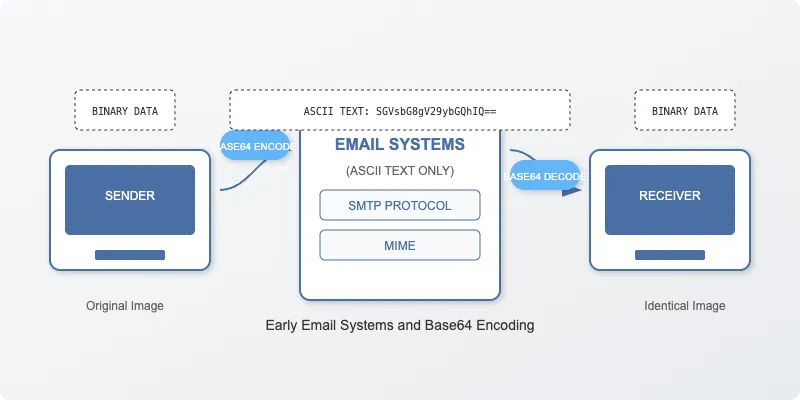The Origins of Base64
Base64 encoding has its roots in the need to transmit binary data through channels that were designed only for text. This challenge became particularly evident during the early days of electronic communication systems in the 1960s and 1970s.
The conceptual foundation of Base64 can be traced back to the development of binary-to-text encoding schemes, which became necessary when computers needed to exchange data across systems with different architectures or through networks that couldn't reliably handle binary data.
The Birth of Base64 in RFC 989
While various binary-to-text encoding schemes existed before, Base64 as we know it today was first formally defined in 1987 in RFC 989, which described "Privacy Enhancement for Internet Electronic Mail: Part III: Algorithms, Modes, and Identifiers." This standard was created to address the challenge of securely transmitting binary data through email systems that were designed only for ASCII text.
The name "Base64" comes from the encoding's use of 64 different ASCII characters (A-Z, a-z, 0-9, +, and /) to represent binary data. The "64" specifically references the number of characters in this set, which conveniently allows each character to represent exactly 6 bits of information (2^6 = 64).

MIME and the Standardization of Base64
The most significant boost to Base64's popularity came in 1992 with the development of MIME (Multipurpose Internet Mail Extensions) standards, defined in RFC 1341. MIME established Base64 as a standard method for encoding binary data in email attachments, allowing people to send images, documents, and other non-text files through email for the first time in a standardized way.
This standardization was crucial for the interoperability of different email systems and clients. Without Base64 encoding, sending a simple image attachment across different email systems would have been unreliable at best and impossible at worst.
Base64 in the Modern Web Era
As the World Wide Web emerged in the 1990s, Base64 found new applications beyond email. Web developers discovered that Base64 could be used to embed binary data directly within HTML and CSS files, reducing the number of separate HTTP requests needed to load a page.
The introduction of data URIs in the early 2000s, as defined in RFC 2397, formalized the use of Base64 for embedding images directly in web pages. This technique became especially valuable for performance optimization as web applications grew more complex.
Variants and Adaptations
Over time, several variants of Base64 emerged to address specific needs:
- URL and Filename Safe Base64 - Modified to replace the "+" and "/" characters with "-" and "_" for use in URLs and filenames
- Base64url - Defined in RFC 4648 for use in URL applications
- Modified Base64 for XML - Used in XML name tokens and identifiers
Legacy and Continued Relevance
Today, Base64 encoding remains a fundamental tool in a developer's toolkit. While newer technologies have emerged, the simplicity and ubiquity of Base64 ensure its continued relevance in modern computing. From embedding fonts in CSS to transmitting data in JSON APIs, Base64 continues to solve the essential problem it was designed for: making binary data compatible with text-based systems.
As we look to the future, Base64 stands as a testament to how elegant, simple solutions can have remarkable staying power in the rapidly evolving world of technology.